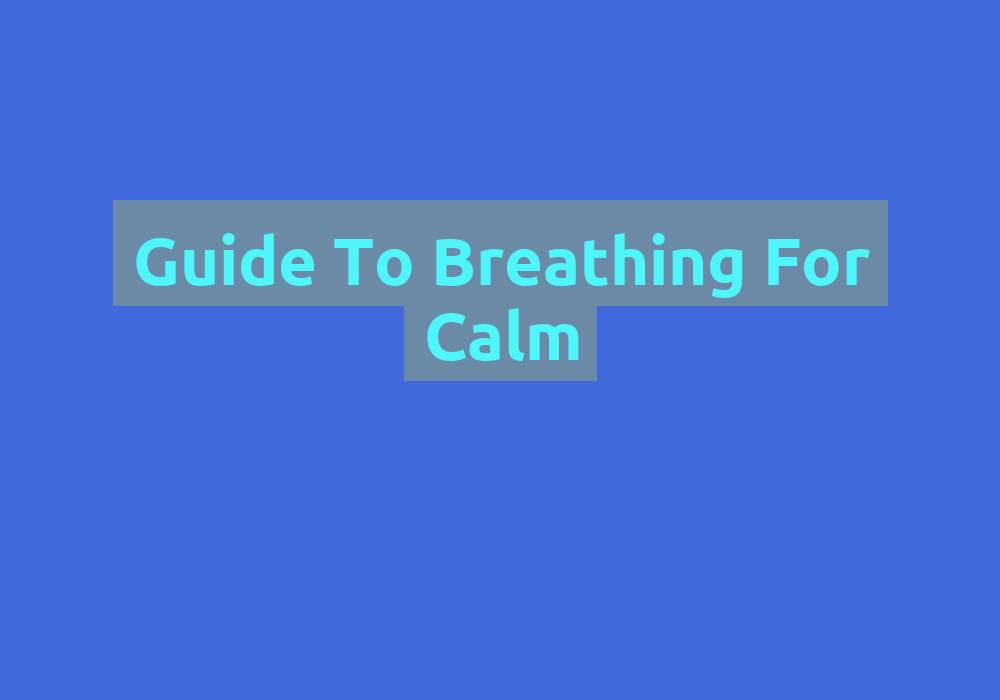Guide to Breathing for Calm

Breathing is not only a basic bodily function but also a powerful tool that can greatly impact our physical, mental, and emotional well-being. By taking the time to understand and practice different breathing techniques, we can find a profound sense of calm and inner peace in our everyday lives. In this comprehensive guide, we will explore various breathing exercises and strategies that can help you achieve tranquility and relaxation.
The Importance of Conscious Breathing
In our busy lives, we often overlook the significance of our breath. Breathing is usually an automatic process controlled by our autonomic nervous system. However, with conscious effort, we can influence the rhythm and depth of our breath, leading to significant wellness benefits. By becoming mindful of our breath, we can release tension, reduce stress, and promote a sense of calmness.
Conscious breathing allows us to tap into the power of the parasympathetic nervous system, also known as the “rest and digest” response. This physiological state counteracts the “fight or flight” response triggered by stress, helping us find a state of relaxation and balance. By intentionally focusing on our breath, we can activate the relaxation response, leading to a cascade of positive effects throughout our body and mind.
Deep Breathing Techniques
One of the simplest and most effective ways to induce calmness is through deep breathing. This technique involves taking slow, deliberate breaths, fully utilizing the capacity of our lungs. Deep breathing allows us to oxygenate our bodies more efficiently and activate the relaxation response. To practice deep breathing, follow these steps:
- Find a comfortable position, either sitting or lying down, where you can fully relax your body.
- Close your eyes and bring your attention to your breath.
- Inhale deeply through your nose, allowing your abdomen to expand as you fill your lungs with air. Count to four as you inhale, focusing on the sensation of your breath entering your body.
- Hold your breath for a brief moment, counting to four. Use this pause to fully experience the sensation of being present in the moment.
- Exhale slowly through your mouth, counting to six, as you release the air from your lungs. Pay attention to the feeling of letting go and releasing any tension or stress.
- Repeat this process for several minutes, allowing your breath to naturally find its own rhythm. As you continue, you may notice a deep sense of relaxation spreading throughout your body.
Deep breathing not only brings immediate calmness but also has long-term benefits. Regular practice can increase lung capacity, improve oxygen flow, and enhance overall respiratory function. It is a versatile technique that can be practiced anytime, anywhere, and can be especially beneficial during moments of stress, anxiety, or discomfort.
Box Breathing Technique
Another effective breathing technique for finding calmness is the box breathing technique. This method involves creating a square pattern with your breath, equalizing each phase. Box breathing helps bring awareness to the breath and promotes a balanced state of mind. Here’s how you can practice box breathing:
- Find a comfortable position where you can sit with an upright posture and close your eyes.
- Inhale deeply through your nose for a count of four, visualizing the breath moving up from your abdomen to your chest.
- Hold your breath for a count of four, maintaining a gentle and relaxed state.
- Exhale slowly through your mouth for a count of four, visualizing the breath moving from your chest to your abdomen.
- Hold your breath once again for a count of four, allowing yourself to find a sense of stillness and presence.
- Repeat this cycle for several minutes, focusing on the square pattern of your breath. As you continue, you may notice a deep sense of balance and equanimity.
Box breathing can be a valuable tool for managing stress, anxiety, and overwhelming emotions. By consciously regulating the breath and focusing on the rhythmic pattern, we can create a sense of stability and calm within ourselves. This technique is particularly useful during high-pressure situations, before important events, or when we need to regain control of our thoughts and emotions.
Alternate Nostril Breathing
In the ancient practice of yoga, alternate nostril breathing, also known as Nadi Shodhana, is often used to balance the flow of energy in the body and promote relaxation. This technique involves breathing in and out through one nostril at a time, alternating between them. To practice alternate nostril breathing:
- Find a comfortable seated position, ensuring that your spine is straight and your body is relaxed.
- Gently close your right nostril with your right thumb and inhale through your left nostril, counting to four. Feel the coolness of the breath as it enters your body.
- Close your left nostril with your ring finger while simultaneously releasing your thumb from your right nostril.
- Exhale through your right nostril for a count of four, experiencing the warmth of the breath as it leaves your body.
- Inhale through your right nostril for a count of four, noticing any subtle sensations that arise.
- Close your right nostril once again and exhale through your left nostril, maintaining a gentle and steady flow of breath.
- Continue this pattern, alternating nostrils, for several minutes. With each cycle, feel the balance and harmony between the left and right sides of your body.
Alternate nostril breathing helps synchronize the left and right hemispheres of the brain, promoting a sense of unity and balance within ourselves. It can be an effective technique for reducing anxiety, calming the mind, and enhancing overall well-being. Regular practice of alternate nostril breathing can also improve focus, concentration, and mental clarity.
Benefits of Breathing for Calm
Engaging in regular breathing exercises can bring about a multitude of benefits for your overall well-being. Let’s explore some of the advantages in more detail:
- Stress Reduction: Deep, controlled breathing triggers the body’s relaxation response, reducing stress hormones such as cortisol and promoting a sense of calmness and tranquility. By consciously regulating our breath, we can create a profound shift in our physical and mental state, allowing us to navigate stressful situations with greater ease.
- Improved Mental Clarity: Proper breathing increases oxygen flow to the brain, enhancing cognitive function and mental clarity. When we breathe deeply and fully, we provide our brain with the essential fuel it needs to perform optimally. This can lead to improved focus, creativity, and problem-solving abilities.
- Enhanced Sleep Quality: Practicing breathing techniques before bed can help relax the body and mind, leading to improved sleep quality. By engaging in deep, slow breathing, we activate the relaxation response and signal to our body that it’s time to unwind and prepare for restful sleep. This can result in more peaceful nights and increased vitality during the day.
- Emotional Balance: Conscious breathing can regulate emotions by activating the parasympathetic nervous system, also known as the “rest and digest” response. By stimulating this part of our nervous system, we can calm racing thoughts, reduce anxiety, and cultivate a sense of emotional stability. Breathing techniques can serve as powerful tools for self-soothing, grounding, and finding inner peace.
- Lowered Blood Pressure: Slow, deep breaths can lower blood pressure and reduce the risk of heart disease. When we breathe deeply, we engage our diaphragm and create a gentle massage-like effect on the organs in our abdominal area. This, in turn, promotes healthy blood circulation, reduces the workload on the heart, and helps maintain optimal blood pressure levels.
Integrating Breathing Techniques into Daily Life
To fully experience the benefits of breathing for calm, it is essential to integrate these techniques into your daily life. Here are some practical tips to help you incorporate breathing exercises into your routine:
- Morning Routine: Begin your day with a few minutes of deep breathing, setting a positive and calm tone for the day ahead. Find a quiet space, take a few deep breaths, and allow yourself to fully arrive in the present moment. This can help you start your day with clarity, focus, and a sense of groundedness.
- Work Breaks: Take short breaks throughout your workday to practice breathing exercises. This can help reduce stress, improve focus, and increase productivity. Find a quiet corner or step outside for a few moments of conscious breathing. Allow yourself to let go of any tension or mental clutter, returning to your tasks with renewed energy and mental clarity.
- Pre-sleep Ritual: Wind down before bed by incorporating a breathing technique into your nighttime routine. This can signal to your body and mind that it’s time to relax and prepare for sleep. Experiment with different techniques, such as deep breathing, box breathing, or alternate nostril breathing, and find what works best for you. As you lie in bed, focus on your breath and allow yourself to surrender to the soothing rhythm of your breath, letting go of the events of the day.
- Mindfulness Practice: Combine breathing exercises with mindfulness meditation. Paying attention to the present moment while focusing on your breath can deepen your sense of calm and awareness. Set aside dedicated time each day for a mindfulness practice that incorporates conscious breathing. As you engage in this practice, observe your breath without judgment, allowing yourself to fully experience the present moment.
Remember, breathing is an invaluable tool that can be accessed at any time to cultivate calmness and inner peace. By incorporating these breathing techniques into your daily routine, you can unlock the potential for a harmonious and balanced life. So take a deep breath, exhale slowly, and embark on a journey of tranquility through the power of conscious breathing.
Q: What is the importance of conscious breathing?
A: Conscious breathing allows us to release tension, reduce stress, and promote a sense of calmness. It activates the relaxation response, leading to positive effects on our body and mind.
Q: What is deep breathing and how do you practice it?
A: Deep breathing involves taking slow, deliberate breaths to fully utilize the capacity of our lungs. To practice deep breathing, find a comfortable position, close your eyes, inhale deeply through your nose, hold your breath briefly, exhale slowly through your mouth, and repeat for several minutes.
Q: What is the box breathing technique and how can it help with calmness?
A: The box breathing technique involves creating a square pattern with your breath by inhaling, holding, exhaling, and holding again for equal counts. This technique brings awareness to the breath and promotes a balanced state of mind, helping manage stress and regain control of thoughts and emotions.
Q: What is alternate nostril breathing and what are its benefits?
A: Alternate nostril breathing involves breathing in and out through one nostril at a time, alternating between them. It helps synchronize the brain hemispheres, reducing anxiety, calming the mind, and improving focus and mental clarity. Regular practice can also enhance overall well-being.

